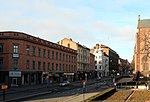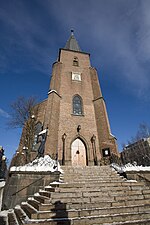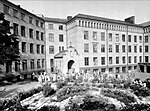Trinity Church (Oslo)

Trinity Church (in Norwegian, Trefoldighetskirken), is a church in the Hammersborg neighborhood in central Oslo, Norway. Trinity Church is neighbor of the government buildings in Regjeringskvartalet. It is the parish church of the parish of Trinity, belonging to the Diocese of Oslo of the Church of Norway. It is one of the largest churches in Oslo (1000 seats). The church itself is in the raw red brick, while the vaults, arches and small columns have gray scale color. The nave is octagonal with a Greek cross superimposed, with the choir in the apse, shallow transept and rectangular entrance flanked by two slender, octagonal bell towers. A central dome rises above the church. Trinity Church is the largest church in Oslo and one of the largest of the many octagonal churches in Norway, but one of few octagonal churches constructed in red brick.
Excerpt from the Wikipedia article Trinity Church (Oslo) (License: CC BY-SA 3.0, Authors, Images).Trinity Church (Oslo)
Akersgata, Oslo St. Hanshaugen
Geographical coordinates (GPS) Address External links Nearby Places Show on map
Geographical coordinates (GPS)
| Latitude | Longitude |
|---|---|
| N 59.916547222222 ° | E 10.745230555556 ° |
Address
Trefoldighetskirken
Akersgata
0180 Oslo, St. Hanshaugen
Norway
Open on Google Maps









